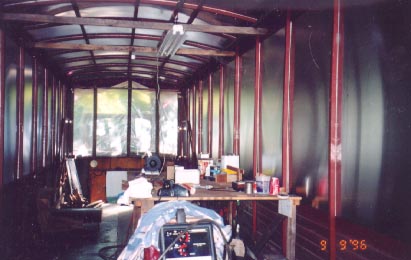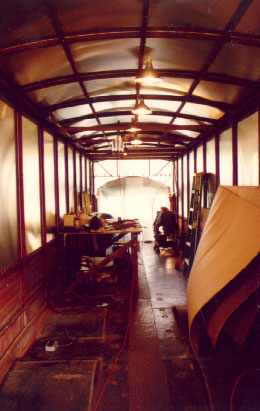Early Crown Photos 6
OK, there you have it so far. The disappointing news is that there are no additional photographs of the bus construction until those you'll see below. During the time that I prepared the framing for sheathing and installed the roof and wall aluminum, I had a roll of film in my 35mm camera. Normally, I purchased 12 or 24 exposure rolls so that I would not have to wait so long to fill up a roll before having it developed. The particular roll of film under discussion went past 12 exposures. Then it went past 24. No problem, I thought, I must have purchased a 36 exposure roll this time. When the counter rolled over 37, 38, 39, I had the sinking feeling that something was wrong. I opened the case of the camera in a dark closet to look inside, thinking perhaps the film had come loose at the end of the roll or broken in half partway through. What I found was that the film had slipped off the take up spool before the first shot and all 38 or 39 exposures were on a single frame. A year's worth or photos ruined.
What didn't get preserved for posterity was the application of many strips of 1 1/4" aluminum. These were contact cemented on most all of the primed steel framing to separate the steel from the skin and more importantly, to remove any "steps" in the framing that would cause the skin to have wrinkles, dips, or bulges where the framing changed levels due to being built up of layers. Hard to explain, but many of the joints were lap joints between framing and rivet plates, etc. The aluminum strip, applied over the lower of the two pieces of metal would give a single plane for the sheathing to cover, so no variations in the surface to account for.
The roof was applied as a single roll of aluminum 40 feet long and 108 inches wide. It was intended as a replacement roof for a mobile home, and had to be custom ordered. In addition to the cost of the material and shipping, there was a "cutting charge" of $70 or so. I rented a crank-operated material lift and secured the help of a friend to hoist it up to the top of the bus, where we rolled it out carefully over a wooden framework that I had rigged up to allow it to lay flat until it was all extended, at which point I removed the wood and the aluminum laid down to cover the arc of the roof.
The roof was caulked all around the edges and literally ~thousands~ of holes drilled through it and the framing underneath so that I could set closed-end pop rivets. After it was all secured, I scribed a line all the way around and used my new pneumatic shears to cut the overhang 1/4" from the facia, leaving a small overhang of aluminum. The finishing touch to the roof was the application of five gallons of "Snow Roof", a white elastomeric coating that sealed all of the rivets and prtected the new aluminum from corrosion.
The sides were a bit easier. Sheets of aluminum 60" wide by 12 feet long were positioned three per side, caulked, and riveted in place, after of course, drilling thousands more holes...

A view to the rear, the back end was left unframed for the winter, with just some 2x4's and plastic to keep the weather out. You can just see the aluminum furring strips between the framing and the skin...
A couple 2x3's span the walls to hold up a shop light. It was very good to have a solid roof on the bus so that rain, snow and particularly, wind were no longer a problem.

View to the front with some clamp lights added for illumination. A 4x8' sheet of plywood formed a work surface. The next task was to fabricate up some steel rivet plates for the front wall and install the aluminum sheet there too. After this was done, I began installing rigid insulation in the roof and walls, eventually installing wood furring strips on both the ceiling and walls, and installing a second layer of insulation over the top of the first to eliminate any interior-to-exterior heat leaks.
And so, that's really about it. The rest of the project from here is contained in the "Photo of the Day" archives on the other part of the site.
Original material ©1996-2025 Mr. Sharkey | All rights reserved
